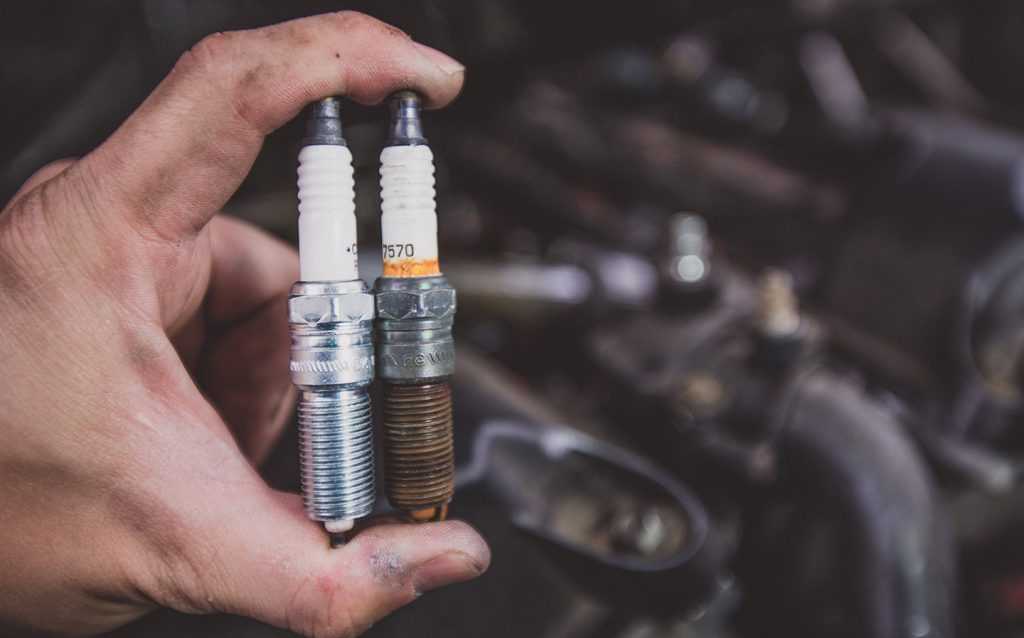The spark plug heat range refers to a measure of the temperature of the spark plug’s tip. This significantly affects engine performance and efficiency, and you must select the correct heat range for your vehicle. This article will explain a spark plug heat range and how it affects engine performance.
To begin with, understanding what spark plugs are will help us understand why spark plug heat ranges are essential. A spark plug is a component in the internal combustion engine that has two primary roles: one is to ignite the air-fuel mixture, and the second is to remove excess heat from the combustion chamber.
To do this, spark plugs have a threaded metal shell that acts as a conduit carrying electrical current from an ignition coil or magneto, causing sparks to jump across its electrode gap when commanded by the engine control unit (ECU). This ignites the air/fuel mixture in preparation for combustion.
The temperature of a spark plug’s tip has an essential effect on its overall performance. When selecting a spark plug for your vehicle, you may come across its corresponding ‘heat range’ number or code – this tells you about how hot or cold that particular spark plug will run when under operating conditions. So what does this mean in practical terms?
The higher the temperature at which it runs (hotter), the better it can remove any excess heat produced by combustion – this helps prevent pre-ignition (when fuel ignites before the spark moves across its gap) and other related problems caused by excessively high temperatures inside your engine.
Reading suggestion: Heat Range Of NGK Spark Plugs
However, suppose your chosen spark plug runs too cold. In that case, there won’t be enough energy generated to produce sustained ignition, meaning that erratic firing could result from insufficient burning or an overly rich air/fuel mixture.
It’s, therefore, essential to consider both your driving style and usage when choosing a suitable spark plug heat range for your car. If you use your vehicle mainly for city driving with frequent stops, then it’s probably best to choose a more relaxed running type such as those indicated with higher numbers (i.e., 10-20).
Alternately, if you use your car mainly on more open roads with more sustained speeds, something around 8-9 might be more suitable for you; this would ensure efficient and consistent burning without producing excessive temperatures inside your engine’s cylinders.
Nevertheless, some engines require specialized components like hot or cold running plugs depending on their specific design – so check on manufacturer recommendations before making any final decisions! Optimal choices can also vary according to altitude due to changes in atmospheric pressure and oxygen levels – something else worth keeping in mind if you drive off-road or uphill regularly!
As always, feel free to consult an experienced mechanic or even take advantage of online forums and communities where discussion abounds overall automotive topics – particularly those related to specialist tuning applications!
How to Properly Select a Spark Plug Heat Range
Choosing the proper spark plug heat range for your engine is essential for optimal performance and efficiency. When selecting a spark plug for your car, you will likely come across its corresponding ‘heat range’ number or code.
This information refers to how hot or cold that particular spark plug will run when under operating conditions. It is essential to consider your driving style, usage, and even altitude when selecting the correct heat range.
When selecting a spark plug heat range, more relaxed running types (higher numbers) are generally preferable if you mainly drive in a city environment with frequent stops. These plugs can help prevent pre-ignition (when fuel ignites before the spark moves across its gap) and other problems caused by excessively high temperatures inside your engine.
On the other hand, if you use your car mainly on open roads with more sustained speeds, something around 8-9 might be more suitable as it ensures efficient and consistent burning without producing excessive temperatures inside your engine’s cylinders.
It’s important to note that the optimal choice of spark plug heat range may also vary according to altitude because of changes in atmospheric pressure and oxygen levels – something worth taking into consideration if you drive off-road or uphill regularly! Additionally, pay attention to the quality of the spark plugs – ensure they are genuine parts from the manufacturer since counterfeit items may not perform as expected!
To understand what type of spark plug is ideal for your vehicle, consult an experienced mechanic or even take advantage of online forums and communities where discussion abounds over all manner of automotive topics – particularly those related to specialist tuning applications!
Moreover, look thoroughly into technical specifications and manuals for more specific advice about which part numbers, materials, etc., should be used under different conditions; all of this information can be obtained easily online nowadays through OEM websites, etc.
Finally, always refer back afterward for verification rather than just assuming something empirically without further guidance!
Importance of Choosing the Correct Heat Range
When it comes to engines, the heat range of your spark plug is an essential factor in optimal performance and efficiency. The heat range indicates how hot or cold a spark plug will run under operating conditions. As such, you must select the correct heat range for your engine to ensure optimal performance and longevity.
The first step towards selecting the correct heat range is assessing your driving style and usage. If you mainly drive in city environments with frequent stops, opt for more relaxed running types (higher numbers).
This can help you prevent pre-ignition (when fuel ignites before the spark moves across its gap) and other problems caused by excessively high temperatures inside your engine’s cylinders.
Besides driving style, consider other factors like altitude and manufacturer recommendations for specialized components like hot or cold running plugs depending on their specific design. The quality of the spark plugs must also be considered – always look for genuine parts from the manufacturer since counterfeit items may not perform as expected!
Finally, technical specifications and manuals can prove invaluable when determining which part numbers and materials should be used under different conditions. Online resources such as OEM websites are great places to start but engaging with experts/specialists is often best to get an accurate assessment tailored specifically towards one’s vehicle type & application.
To summarize: understanding what makes up different types of ‘spark plug heat range’ is essential when looking after our vehicular engines properly – they provide short-term protection against pre-ignition and longer-term protection from corrosion due to excessive temperatures near their tips under certain operating conditions!
It’s always wise, however – especially with more complex scenarios involving vehicles requiring tuning kits, etc. – to refer back afterward again for verification rather than just assuming something empirically without any further guidance at hand!





